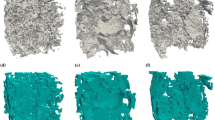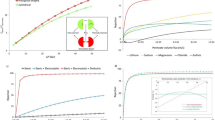Abstract
The fluid flow and heat transfer in porous media are not only related to the physical properties of the fluid itself, but also related to the structure and distribution of the pore space of porous media. The reconstruction of porous media has become a prerequisite for the research and analysis of the microscopic pore structure. At present, numerical simulation methods are widely used in the field of porous media reconstruction, which can achieve reconstructed results similar to the real pore structure, but generally the whole process is CPU-intensive and time-consuming. With the widespread application of deep learning in many scientific fields, although generative adversarial network (GAN), as a branch of deep learning generative models, has the strong ability of feature extraction and prediction, it is challenged by the large CPU/memory consumption in training. One solution is to perform multi-scale reconstruction, which has been used in the variants of GAN. Based on multi-scale reconstruction, smaller-scale training samples can be used to reconstruct larger-scale samples with the benefits of a much faster speed than traditional numerical simulation methods and lower burdens on CPU/memory. Hence, this paper proposes a progressively growing multi-scale GAN model for the reconstruction of porous media. Compared with some variants of GAN and traditional numerical simulation methods, the effectiveness and practicability of our method are proved.





taken from real sandstone sample TIbig (128 × 128 × 128)

taken from real shale sample TIfrac_big (64 × 64 × 64)









Similar content being viewed by others
Availability of data and codes
The data and codes used to support this study are available from GitHub (https://github.com/FPXMU/MS-GAN).
References
Arjovsky M, Chintala S, Bottou L (2017) Wasserstein GAN. arXiv preprint arXiv: 1701.07875
Arns CH, Bauget F, Ghous A, Sakellariou A, Senden TJ, Sheppard AP, Sok RM, Pinczewski WV, Kelly JC, Knackstedt MA (2005) Digital core laboratory: petrophysical analysis from 3D imaging of reservoir core fragments. Petrophysics 46:260–277
Bai Y, Wang DL (2010) On the comparison of trilinear, cubic spline, and fuzzy interpolation methods in the high-accuracy measurements. IEEE Trans Fuzzy Syst 18:1016–1022
Blunt MJ, Bijeljic B, Hu D, Gharbi O, Iglauer S, Mostaghimi P, Paluszny A, Pentland C (2013) Pore-scale imaging and modelling. Adv Water Resour 51:197–216
Denton E, Chintala S, Szlam A, Fergus R (2015) Deep generative image models using a laplacian pyramid of adversarial networks. arXiv preprint arXiv: 1506.05751
Dong H, Blunt MJ (2009) Pore-network extraction from micro-computerized-tomography images. Phys Rev E - Statis, Nonlinear, Soft Matter Phys 80:036307
FEI C (2009) Avizo 9 User's Guide. FEI Corporation
Fredrich JT (1999) 3D imaging of porous media using laser scanning confocal microscopy with application to microscale transport processes. Phys Chem Earth Part A 24:551–561
Goodfellow IJ, Pouget-Abadie J, Mirza M, Xu B, Warde-Farley D, Ozair S, Courville A, Bengio, Y (2014) Generative adversarial networks. arXiv preprint arXiv: 1406.2661
Gulrajani I, Ahmed F, Arjovsky M, Dumoulin V, Courville A (2017) Improved training of Wasserstein GANs. arXiv preprint arXiv: 1704.00028
Hélène B, Didier R (2016) Truncated Gaussian and derived methods. CR Geosci 348:510–519
Hou J, Zhang SK, Sun RY, Li ZQ, Li YB (2007) Reconstruction of 3D network model through CT scanning. 69th European association of geoscientists and engineers conference and exhibition 2007: securing the future. Incorporating SPE EUROPEC 6:3398–3408
Ji LL, Lin M, Jiang WB, Wu CJ (2018) An improved method for reconstructing the digital core model of heterogeneous porous media. Transp Porous Media 121:389–406
Jiao Y, Stillinger FH, Torquato S (2008) Modeling heterogeneous materials via two-point correlation functions II Algorithmic details and applications. Phys Rev E 77:031135
Karras T, Aila T, Laine S, Lehtinen J (2018) Progressive growing of GANs for improved quality, stability, and variation. arXiv preprint arXiv: 1710.10196
Krishnan T, Journel AG (2003) Spatial connectivity: from variograms to multiple-point measures. Math Geol 35:915–925
Larsen ABL, Sønderby SK, Larochelle H, Winther O (2016) Autoencoding beyond pixels using a learned similarity metric. arXiv preprint arXiv: 1512.09300
Liang Z, Ioannidis MA, Chatzis I (2000) Geometric and topological analysis of three-dimensional porous media: pore space partitioning based on morphological skeletonization. J Colloid Interface Sci 221:13–24
Lin W, Li XZ, Yang ZM, Wang J, Xiong SC, Luo YT, Wu GM (2017) Construction of dual pore 3-D digital cores with a hybrid method combined with physical experiment method and numerical reconstruction method. Transp Porous Media 120:227–238
WB Lindquist (2002) Quantitative analysis of three dimensional X-ray tomographic images. In: Proceedings of SPIE - the international society for optical engineering 4503: 103–115
Liu YH (2006) Using the Snesim program for multiple-point statistical simulation. Comput Geosci 32:1544–1563
Lymberopoulos DP, Payatakes AC (1992) Derivation of topological, geometrical, and correlational properties of porous media from pore-chart analysis of serial section data. J Colloid Interface Sci 150:61–80
Mao XD, Li Q, Xie HR, Lau Raymond YK, Wang Z, Stephen PS (2017) Least squares generative adversarial networks. arXiv preprint arXiv: 1611.04076
Mirza M, Osindero S (2014) Conditional generative adversarial nets. arXiv preprint arXiv: 1411.1784
Mosser L, Dubrule O, Blunt MJ (2017) Reconstruction of three-dimensional porous media using generative adversarial neural networks. Phys Rev E 96:043309
Okabe H, Blunt MJ (2004) Prediction of permeability for porous media reconstructed using multiple-point statistics. Phys Rev E - Statis Nonlinear Soft Matter Phys 70:066135
Okabe H, Blunt MJ (2005) Pore space reconstruction using multiple-point statistics. J Petrol Sci Eng 46:121–137
Prodanović M, Lindquist WB, Seright RS (2006) Porous structure and fluid partitioning in polyethylene cores from 3D X-ray microtomographic imaging. J Colloid Interface Sci 298:282–297
Radford A, Metz L, Chintala S (2016) Unsupervised representation learning with deep convolutional generative adversarial networks. arXiv preprint arXiv: 1511.06434
Singh M, Mohanty KK (2000) Permeability of spatially correlated porous media. Chem Eng Sci 55:5393–5403
Strebelle S (2002) Conditional simulation of complex geological structures using multiple-point statistics. Math Geol 34:1–21
Sun J, Jiang L, Liu X, Wang H, Yan G, Zhao J (2012) Log application and prospect of digital core technology. Well Logging Technol 36:112–121
Tahmasebi P, Javadpour F, Sahimi M (2015) Three-dimensional stochastic characterization of shale SEM Images. Transp Porous Media 110:521–531
Valsecchi A, Damas S, Tubilleja C, Arechalde J (2020) Stochastic reconstruction of 3D porous media from 2D images using generative adversarial networks. Neurocomputing 399:227–236
Villani C (2019) Optimal transport: old and new. Grundlehren der mathematischen Wissenschaften, Springer, Berlin
Vogel HJ, Roth K (2001) Quantitative morphology and network representation of soil pore structure. Adv Water Resour 24:233–242
Wu KJ, Nunan N, Crawford JW, Young IM, Ritz K (2004) An efficient Markov chain model for the simulation of heterogeneous soil structure. Soil Sci Soc Am J 68:346–351
Zhang T, Du Y, Huang T, Yang JQ, Lu FF, Li X (2016) Reconstruction of porous media using ISOMAP-based MPS. Stoch Env Res Risk Assess 30:395–412
Zhang F, Teng QZ, Chen HG, He XH, Dong XC (2021) Slice-to-voxel stochastic reconstructions on porous media with hybrid deep generative model. Comput Mater Sci 186:110018
Zhang H, Xu T, Li HS, Zhang ST, Wang XG, Huang XL, Metaxas D (2017) StackGAN: Text to photo-realistic image synthesis with stacked generative adversarial networks. arXiv preprint arXiv: 1612.03242
Zhu JY, Park T, Isola P, Efros AA (2020) Unpaired image-to-image translation using cycle-consistent adversarial networks. arXiv preprint arXiv: 1703.10593
Funding
This work is supported by the National Natural Science Foundation of China (Nos. 41672114, 41702148).
Author information
Authors and Affiliations
Contributions
Pengfei Xia did most experiments and helped to write the paper. Hualin Bai did part of experiments and helped to revise the text. Ting Zhang proposed the main idea of the paper and wrote the paper.
Corresponding author
Ethics declarations
Conflicts of interest
The authors declare that they have no conflicts of interest.
Additional information
Publisher's Note
Springer Nature remains neutral with regard to jurisdictional claims in published maps and institutional affiliations.
Rights and permissions
About this article
Cite this article
Xia, P., Bai, H. & Zhang, T. Multi-scale reconstruction of porous media based on progressively growing generative adversarial networks. Stoch Environ Res Risk Assess 36, 3685–3705 (2022). https://doi.org/10.1007/s00477-022-02216-z
Accepted:
Published:
Issue Date:
DOI: https://doi.org/10.1007/s00477-022-02216-z




